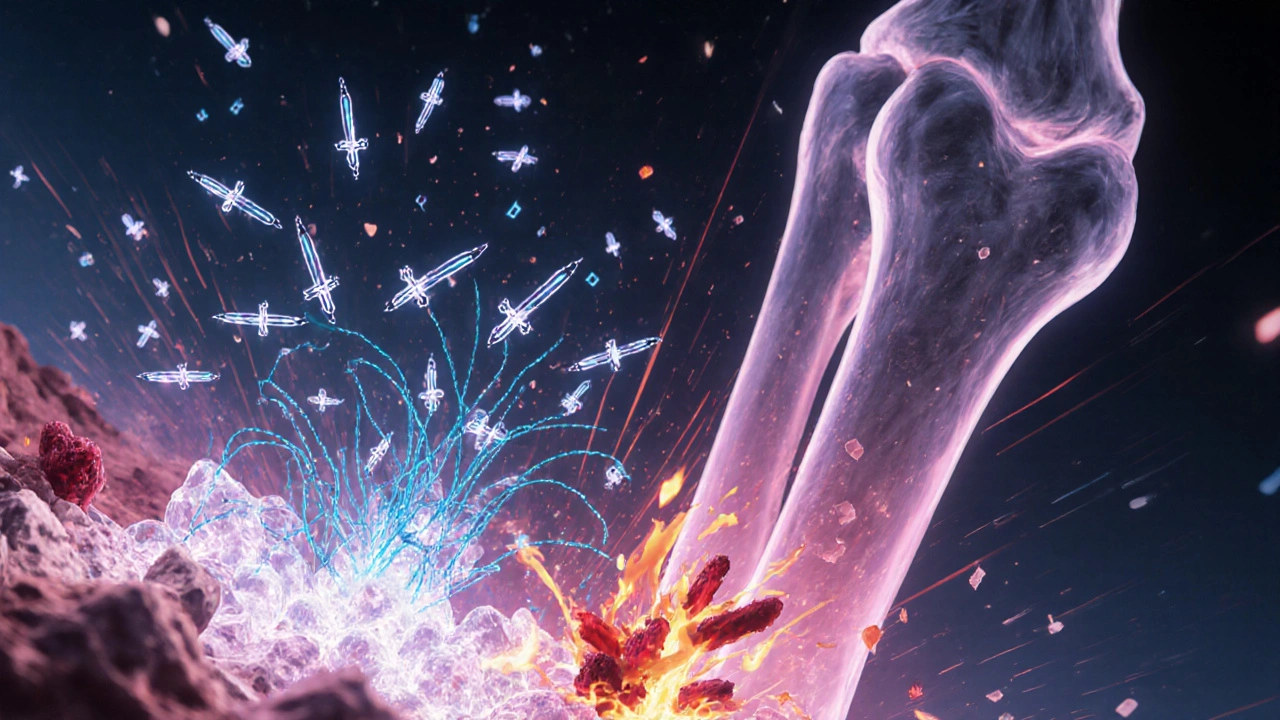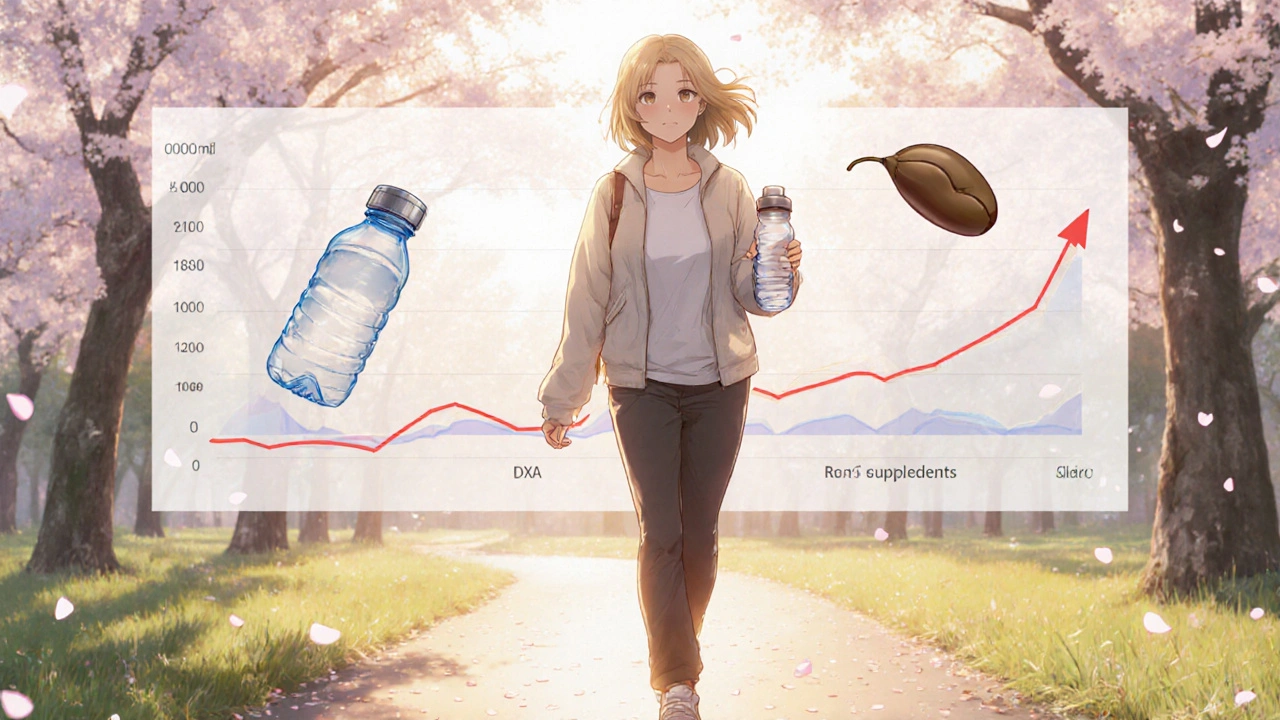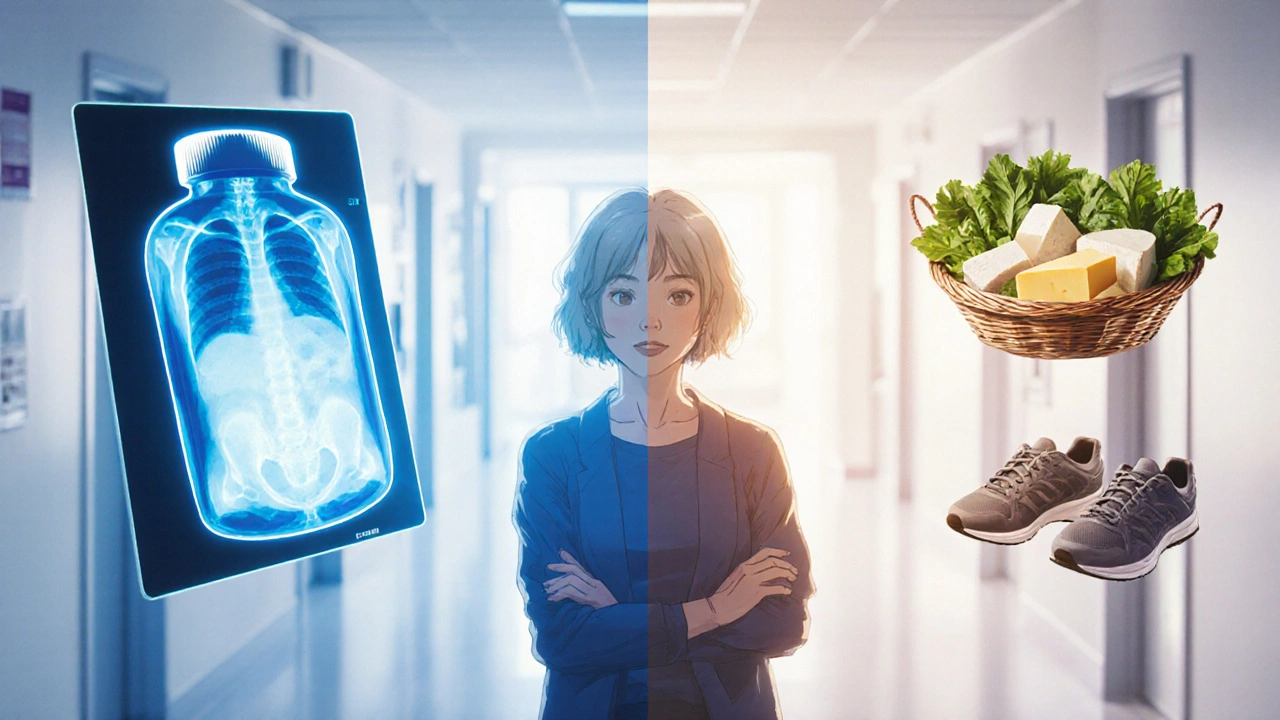Osteoporosis Treatment Effectiveness Estimator
Your Personal Factors
Enter your details to see how different treatments affect your fracture risk
Treatment Comparison
Alendronate (Bisphosphonate)
• 40-50% reduction in vertebral fracture risk
• 4-6% improvement in lumbar spine BMD
• Requires strict dosing protocol
Natural Remedies
• 15-25% reduction in fracture risk
• 1-3% BMD improvement with supplements
• Requires consistent lifestyle changes
When faced with osteoporosis is a condition that weakens bones, many wonder whether to rely on prescription drugs like Alendronate a bisphosphonate that slows bone loss or turn to natural remedies dietary and lifestyle approaches that support bone health. This guide breaks down the science, benefits, and drawbacks of each option so you can make an informed choice.
Understanding Osteoporosis
Osteoporosis a chronic disease marked by low bone mass and structural deterioration affects roughly 10 % of people over 50 worldwide. The hallmark is a drop in bone mineral density (BMD), which raises the risk of fractures, especially in the hip, spine, and wrist. Risk factors include age, hormonal changes, low calcium intake, sedentary lifestyle, and certain medications.
How Alendronate Works
Alendronate belongs to the bisphosphonate class and is taken orally, usually once a week. It binds to hydroxyapatite crystals in bone, making them less accessible to osteoclasts-the cells that break down bone. By inhibiting osteoclast activity, Alendronate reduces bone resorption, gradually allowing bone formation to catch up.
Clinical trials consistently show a 40‑50 % reduction in vertebral fracture risk after three years of therapy. The drug also modestly improves BMD, with average increases of 4‑6 % at the lumbar spine and 2‑3 % at the hip.
Benefits and Risks of Alendronate
- Efficacy: Strong evidence for preventing spine, hip, and non‑vertebral fractures.
- Convenient dosing: Once‑weekly or once‑monthly tablets fit most schedules.
- Long‑term data: Over a decade of safety monitoring by the FDA and regulatory agencies.
However, the medication isn’t without downsides:
- Gastro‑intestinal irritation - esophageal ulceration if the tablet isn’t taken with water and the patient remains upright for 30 minutes.
- Rare but serious adverse events - osteonecrosis of the jaw (ONJ) and atypical femur fractures after many years of use.
- Requirement for periodic monitoring - BMD scans every 1‑2 years and serum calcium checks.
Patients with severe kidney disease (eGFR < 30 mL/min) are generally advised against Alendronate because the drug is cleared renally.

Natural Remedies for Osteoporosis
While no supplement matches the fracture‑prevention power of a prescription bisphosphonate, several natural approaches have solid research backing and can complement or, in mild cases, replace medication under medical supervision.
- Calcium the primary mineral in bone tissue - Adults need 1,000‑1,200 mg per day, ideally split between dietary sources (dairy, leafy greens, fortified foods) and supplements if intake is low.
- Vitamin D a fat‑soluble vitamin that enhances calcium absorption - 800‑1,000 IU daily is the target for most adults; higher doses (2,000 IU) may be needed in winter months or for people with limited sun exposure.
- Soy Isoflavones plant compounds that act like weak estrogen in bone tissue - Meta‑analyses show a modest 1‑2 % increase in BMD after 12 months of 80‑100 mg daily.
- Weight‑Bearing Exercise activities that force the skeleton to support the body’s weight - Resistance training, brisk walking, and dancing stimulate osteoblast activity, slowing bone loss.
- Other botanicals - Black cohosh, prune juice, and dried plum powders have shown small BMD gains in pilot studies, but evidence is still limited.
These remedies work best when combined: adequate calcium + vitamin D provides the raw material, while exercise and phytoestrogens encourage the body to lay down new bone.
Direct Comparison: Alendronate vs Top Natural Options
| Aspect | Alendronate (Prescription) | Calcium + Vitamin D | Soy Isoflavones | Weight‑Bearing Exercise |
|---|---|---|---|---|
| Fracture‑Risk Reduction | 40‑50 % (clinical trials) | 5‑10 % (meta‑analysis) | ~2 % (small RCTs) | 10‑15 % (consistent across studies) |
| Increase in BMD (2 yr) | 4‑6 % (spine) / 2‑3 % (hip) | 1‑3 % (spine) / 0‑1 % (hip) | 1‑2 % (spine) | 2‑4 % (spine) / 1‑2 % (hip) |
| Common Side Effects | Esophageal irritation, musculoskeletal pain | Constipation, rare hypercalcemia | GI upset, possible thyroid interference | Joint soreness (temporary) |
| Serious Risks | ONJ, atypical femur fracture (long‑term) | Kidney stones (high dose) | None documented | None documented |
| Regulatory Status | FDA‑approved prescription drug | OTC supplement (dietary) | OTC supplement (dietary) | Lifestyle recommendation |
The table makes it clear: Alendronate offers the steepest drop in fracture risk, but it comes with prescription‑only constraints and rare serious side effects. Natural options are safer, cheaper, and promote overall health, yet they deliver more modest bone gains.

Decision Guide: When to Choose Medication, When to Lean Natural
- Severity of bone loss: If your T‑score is ≤ ‑2.5 and you’ve already had a fracture, most clinicians recommend starting a bisphosphonate.
- Medical history: Chronic kidney disease, esophageal disorders, or a history of ONJ may push you toward natural strategies.
- Age and duration of therapy: Younger post‑menopausal women (< 60) often benefit from a trial of calcium, vitamin D, and exercise for 12‑18 months before considering drugs.
- Personal preference: Some patients dislike daily pills or fear side effects and opt for a supplement‑first approach.
- Insurance coverage: Prescription costs can be a barrier; natural options are generally out‑of‑pocket but cheaper.
In practice, many doctors prescribe a low‑dose bisphosphonate alongside calcium, vitamin D, and a tailored exercise plan. This hybrid approach harnesses the strengths of both worlds.
Practical Checklist Before Starting or Switching Therapy
- Schedule a baseline DXA scan to document BMD.
- Get serum calcium, vitamin D, and renal function labs.
- If considering Alendronate, confirm you can take the tablet with a full glass of water and stay upright for at least 30 minutes.
- Choose a calcium supplement that provides 500 mg elemental calcium per dose; avoid excessive total calcium (> 2,500 mg/day).
- Aim for 800‑1,000 IU vitamin D daily; consider a higher dose if labs show < 20 ng/mL.
- Incorporate weight‑bearing activity at least 3 times per week (e.g., brisk walking 30 min, resistance bands, or stair climbing).
- Set a follow‑up appointment in 12 months to repeat DXA and reassess fracture risk.
Keeping a simple log of supplement intake, exercise, and any side effects helps your healthcare provider fine‑tune the plan.
Key Takeaways
- Alendronate is the most potent single agent for reducing fractures, but it requires strict dosing rules and carries rare serious risks.
- Calcium, vitamin D, soy isoflavones, and consistent weight‑bearing exercise are safe, affordable ways to support bone health and may be sufficient for mild osteoporosis.
- Combine approaches when possible: medication for high‑risk patients, natural strategies for overall wellness and risk reduction.
- Regular monitoring (DXA, labs) is essential regardless of the chosen path.
Can I stop Alendronate once my BMD improves?
Most guidelines advise a “drug holiday” after 3‑5 years of continuous bisphosphonate use, provided your fracture risk remains low. You’ll need a follow‑up DXA and a discussion with your doctor before stopping.
How much calcium is enough for osteoporosis?
Aim for 1,000 mg daily if you’re under 50, and 1,200 mg if you’re over 50. Split the dose (e.g., 600 mg with breakfast, 600 mg with dinner) to maximize absorption.
Is vitamin D supplementation necessary if I get sunlight?
Sun exposure can provide vitamin D, but factors like latitude, skin tone, and sunscreen use often limit synthesis. Blood testing is the most reliable way to decide on a supplement.
Do soy products raise estrogen levels and cause hormonal issues?
Soy isoflavones act as weak phytoestrogens, but research shows they don’t significantly alter hormone levels in most adults. They are considered safe for bone health when consumed in moderate amounts.
What are the warning signs of osteonecrosis of the jaw?
Pain, swelling, or exposed bone in the jaw, especially after dental work, can signal ONJ. Anyone on bisphosphonates should see a dentist before invasive procedures.



10 Comments
parth gajjar October 19, 2025 AT 17:22
The clash of Alendronate and ancient herbs reads like a tragic opera where our fragile skeletons are the unwilling protagonists!
Maridel Frey October 26, 2025 AT 15:02
When selecting a treatment plan, it is essential to weigh the absolute risk reduction against the individual’s comorbidities. A shared decision‑making approach that incorporates calcium, vitamin D, and weight‑bearing exercise alongside-or in place of-pharmacotherapy often yields the most sustainable outcomes.
DHARMENDER BHATHAVAR November 2, 2025 AT 13:42
Alendronate offers the strongest fracture risk reduction, but lifestyle measures can complement therapy.
Jay Kay November 9, 2025 AT 12:22
People often overlook the fact that the pill can cause real stomach pain and rare jaw issues.
Rakhi Kasana November 16, 2025 AT 11:02
While the drug’s potency is undeniable, the narrative that dismisses natural interventions as merely supplemental belies a deeper bias. The literature shows that weight‑bearing activity can restore a modest fraction of bone density, and for many patients that translates into meaningful functional improvement. Ignoring these gains in favor of a one‑size‑fits‑all pill undercuts holistic care.
James Dean November 23, 2025 AT 09:42
The bone is a metaphor for resilience, and the choices we make echo beyond the clinic. Chemistry and tradition each hold a fragment of truth.
Monika Bozkurt November 30, 2025 AT 08:22
From a mechanistic perspective, bisphosphonates inhibit osteoclast‑mediated resorption via hydroxyapatite binding, whereas phytoestrogens modulate RANKL expression. Integrating these modalities within a calibrated therapeutic algorithm can optimize skeletal turnover rates.
Penny Reeves December 7, 2025 AT 07:02
The pharmacodynamics of Alendronate are well characterized, with a binding affinity that outpaces most natural chelators.
The clinical trials consistently report a 40 to 50 percent reduction in vertebral fractures over a three‑year horizon.
Such efficacy, however, is accompanied by a regimen that demands strict adherence to dosing instructions.
Patients must consume a full glass of water and remain upright for at least thirty minutes, a constraint that many find cumbersome.
Gastro‑intestinal irritation remains one of the most common adverse events, manifesting as esophagitis or dyspepsia.
Rare but serious complications such as osteonecrosis of the jaw or atypical femoral fractures emerge after prolonged exposure.
Conversely, calcium and vitamin D supplementation address the substrate necessary for mineralization without invoking systemic toxicity.
The synergistic effect of these nutrients with weight‑bearing exercise can yield modest but clinically relevant improvements in bone mineral density.
Soy isoflavones act as selective estrogen receptor modulators, offering a hormonal milieu that supports osteoblastic activity.
Their impact, while statistically modest, may be amplified when combined with resistance training protocols.
From a health economics standpoint, over‑the‑counter supplements and lifestyle modifications incur minimal direct costs compared to prescription therapy.
Insurance coverage gaps and copayment structures often drive patients toward self‑managed regimens.
Nevertheless, for individuals with a T‑score below –2.5 or a recent fragility fracture, the absolute risk reduction afforded by Alendronate can be life‑saving.
The decision matrix thus hinges on a nuanced assessment of fracture risk, comorbid conditions, and patient preference.
A drug holiday after three to five years of bisphosphonate use is supported by emerging guidelines, provided bone density remains stable.
Ultimately, a blended strategy that leverages the potency of pharmacology while embracing the holistic benefits of nutrition and exercise offers the most comprehensive protection against skeletal deterioration.
Sunil Yathakula December 14, 2025 AT 05:42
I totally get the struggle keep up with the supplements!
Catherine Viola December 21, 2025 AT 04:22
The hidden agenda of big pharma fuels the hype around bisphosphonates.